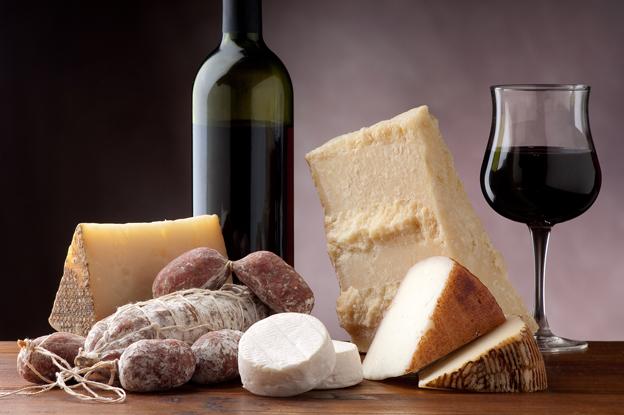Rosso o Bianco? In Italy, this is often the only decision we need to make when choosing which wine to accompany our meal in a restaurant - for restaurant owners inevitably take huge pride in their house wines, sniffing out producers who can supply them with genuine wines that are excellent as well as good value.
Undoubtedly, a well-paired match in wine and food can really enhance a meal and an occasion, whether in a restaurant or for a home-cooked meal. The flavours and scents of a good, intelligently-chosen wine can complement immeasurably the flavours and scents of a carefully prepared dish, a happy and successful marriage lifting both to a higher plane. On the other hand, a wine that is utterly unsuitable for the dish that it accompanies can have the effect of diminishing both so that neither food nor wine show their best.
So it really is worth giving this some thought when planning a menu or choosing wines in a restaurant, if only to avoid potentially costly disappointments.
Rules are there to be broken

The first rule when matching wine and food, is quite simply that there are no hard and fast rules. Even such a basic caveat as white wine with fish, red with meat is not necessarily valid.
Yes, a delicate simply-prepared sea bass fillet in a light sauce might clash with the harsher tannins of a big red wine. However, a robustly flavoured, Mediterranean fish stew, redolent of garlic, onions and tomatoes, might well be better partnered with an equally gutsy and forthright red wine rather than a delicate white. On the other hand, a full-flavoured, traditional white might go just as well.
So the moral is: don’t worry too much about it and in the end, choose a wine that you yourself enjoy drinking with a particular food. Chances are that if you enjoy it, then your guests will, too.
Classic regional and local combinations

When it comes to Italian wine and food, certain tried and tested regional and local combinations simply can’t be beaten.
A genuine bistecca alla fiorentina, from the Chianina breed, three fingers thick, cooked perfectly over glowing wood embers, and seasoned simply with a pinch of sea salt and a drizzle of olio extra vergine d’oliva, simply cries out to be accompanied by a crystal goblet or two of a super-Tuscan Sangiovese or a Chianti Classico riserva from a top producer.
A plate of prosciutto di San Daniele is exquisite washed down with a flute of creamy, soft Prosecco from the nearby cru Cartizze zone. Coniglio in porchetta, the rabbit stuffed with copious amounts of wild fennel and garlic and cooked in a wood-fired oven, is a classic of Le Marche, and delicious accompanied by a richly flavoured Rosso Cûnero.
What about brasato al Barolo, beef braised in that king of wines and accompanied by a mature bottle? The rich and substantial foods of Bologna ‘La Grassa’ are accompanied by nothing quite so well as a vivid, foaming glass of Lambrusco; indeed, this internationally-maligned wine, on its home turf, can be outstanding: raspingly dry, low in alcohol, and able to cut through the fat of the rich cucina bolognese.
And to finish, another classic regional combination: cantuccini di Prato, the crunchy biscotti partnered by, what else, a fine, traditional Vin Santo from the wine hills of Florence.
It is not that other wines would not be suitable partners to such foods; of course they could be. But in pairing regional and classic dishes with the wines from their locality, a richer layer of complexity is added: these combinations have worked, have been enjoyed, by, literally, generations and for centuries. To miss out on them is to miss part of the quintessential Italian experience.
By grape style and intensity of flavours

Even in Italy, we don’t always eat regional foods. Today, cooking styles and influences from around the world proliferate. Similarly, styles and flavours of wine are equally varied. Another approach, therefore, is to try and match a food with a particular wine by grape, by style, or by intensity of flavour.
-
An oaked Chardonnay (yes, increasingly such wines are produced in Italy) might be the perfect partner to fish or shellfish in a rich, buttery sauce. On the other hand, a light, zesty, white made from Pinot Bianco would be chosen to go with simply steamed or grilled fish and shellfish, its citrus acidity a natural partner to the seafood.
-
Barbera is another grape variety noted for its relatively high acidity; this popular red wine might be chosen for its ability to partner rich or rather fatty foods, perhaps a selection of salumi, or a steaming platter of boiled meats.
Elements to consider with a wine are its sweetness, acidity, alcohol level and, for red wines, tannin (the stewed tea sensation certain red wines leave in your mouth). Consider the foods you will be serving and how these vinous components will interact.
-
Spicy Asian-influenced foods might go best with an aromatic, off-dry white wine from Trentino-Alto Adige, say a Traminer Aromatico, Rulander or Muller Thurgau. Such wines may not sound very Italian but they can be superb and versatile accompaniments to a wide range of international foods.
-
Rosato is another style of wine often overlooked: try good full-bodied examples from Puglia’s Salento peninsula to accompany lighter meals or lunches.
-
Seriously robust and forthright wines, on the other hand, such as Amarone della Valpolicella or a mature Brunello di Montalcino, full-bodied and high in alcohol, might best be simply savoured on their own with no distraction of food except, perhaps, for a good nugget of parmigiano reggiano stravecchio.
Cin cin e buon appetito!
Related stories
From Aglianico to Zibibbo: an easy a-z of Italian grapes.
Le città del vino.
Three of the best wineries to visit in Italy.
Cantine Aperte.
Book of the Week: Vino Italiano.













